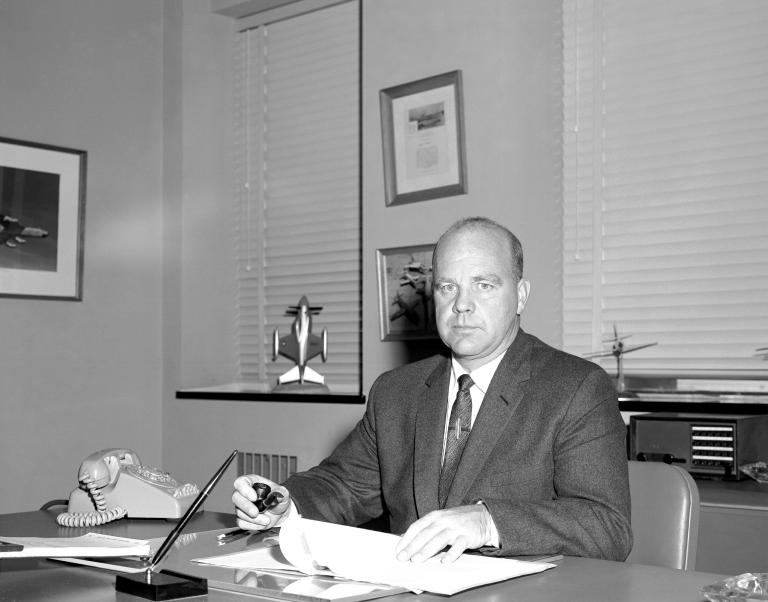
Paul F. Bikle
Former Armstrong Center Director
Formerly technical director of the U.S. Air Force Flight Test Center at Edwards Air Force Base in California, Paul F. Bikle became director of NASA’s Dryden (now Armstrong) Flight Research Center in Edwards, California, in September 1959.
On Sept. 15, 1959, Bikle became chief of NASA’s High-Speed Flight Station (HSFS). Later that month, the HSFS became NASA’s Flight Research Center, and Bikle became its director, a position he held with distinction until 1971. On April 27, 1971, he announced his retirement effective May 31, 1971, and his deputy director, De E. Beeler, became acting director with Bikle serving in an advisory role until his retirement.
As director of the NASA facility, Bikle was responsible for the flight operation of many major aeronautical research programs, including the highly successful rocket-powered X-15, the supersonic XB-70, the Lunar Landing Research Vehicle, and the wingless lifting bodies, forerunners of the space shuttle and reusable boosters.
Bikle’s career with the Air Force began in 1940 when he was appointed an aeronautical engineer at Wright Field. In 1944, he was named chief of the Aerodynamics Branch in the Flight Test Division there. While working closely with other government agencies in establishing the first flying qualities specifications for aircraft he also wrote AAF Technical Report 5069, “Flight Test Methods,” which was used as a standard manual for conducting flight tests for more than five years. During the war years he was involved in more than 30 test projects and flew more than 1,200 hours as an engineering observer.
Projects with which Bikle has been associated include the development of an all-altitude speed course, an adaptation of radar tracking to flight test work, a tour of test facilities in Great Britain in 1945, and a study of long-range operations and effects of high humidity on available engine power for takeoff on the B-29 airplane conducted on Guam in late 1945.
In 1947, after the first glide flights of the XS-1, Bikle participated in early plans for powered flights later made by Major Charles E. Yeager. Returning to aircraft evaluation in 1947, he was appointed chief of the Performance Engineering Branch and directed tests of the XB-43, the first jet bomber; the XC-99; and the F-86A. With the transfer of this part of the flight test mission to the newly formed Air Force Flight Test Center at Edwards, he advanced to assistant chief of the Flight Test Engineering Laboratory in 1951. In this capacity, he directed the engineering phase of the flight evaluation of the Russian MiG-15 on Okinawa in 1953.
In 1954, Bikle was appointed technical director of the Directorate of Flight Test at Edwards. One year later he was named technical director of the Flight Test Center. In this capacity, he was responsible for the engineering and scientific activities of the center, including flight test, missile test and parachute development testing.
Before graduating from the University of Detroit in 1939 with a Bachelor of Arts in aeronautical engineering, Bikle’s activity in the student chapter of the Institute of the Aeronautical Sciences and the school flying and gliding club led to flight instruction and qualification for a Civil Aviation Authority (CAA) pilot’s license.
After graduation, he was employed in the engineering department of the Taylorcraft Aviation Corp. in Alliance, Ohio, where he specialized in stress analysis and design. While with Taylorcraft, he was responsible for obtaining CAA approval on modifications, which permitted an increase in gross weight and horsepower for the standard Taylorcraft airplane.
The author of more than 40 technical publications, Bikle was also an avid soaring enthusiast. On February 25, 1961, he established two world soaring records during a flight near Lancaster, California. He achieved and altitude of 46,269 feet and a total-altitude-gained mark of 42,305 feet. Both marks were certified by the Soaring Society of America, National Aeronautical Association and the Federation Aeronautique Internationale.
A veteran of 23 years soaring, Bikle won the Wright Memorial Soaring Championship in 1949. In 1959 and 1960, he was a member of the U.S. Soaring team, taking part in international meets in Poland and Germany.



























